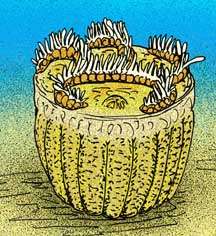Camptostroma
| Camptostroma Temporal range: Early Cambrian | |
|---|---|
 | |
| Artist's reconstruction | |
| Scientific classification | |
| Kingdom: | Animalia |
| Phylum: | Echinodermata |
| Class: | †Edrioasteroidea |
| (unranked): | Camptostromatoidea |
| Genus: | Camptostroma |
| Species: | C. roddyi Hundt 1939 |
Camptostroma roddyi is an extinct echinoderm from the Bonnia-Olenellus Zone the Early Cambrian Kinzers Formation near York and Lancaster, Southeastern Pennsylvania.[1] In life, it would have resembled a cupcake, with the axial skeleton forming a star pattern on the upper surface. It was originally thought, on the basis of its medusoid shape, to be a jellyfish-like organism, but the fossils themselves clearly rule out the possibility of a gelatinous body - the stereom plates are clearly preserved and possess the calcitic cleavage pattern diagnostic of echinoderms.[1] It has been placed in a class of basal echinoderms, the Edrioasteroids.[2]
Other species have been described from time to time, but all have since been reassigned to other genera - and often different phyla.[2]
References
- 1 2 Durham, J. W. (1 September 1966). "Camptostroma, an Early Cambrian Supposed Scyphozoan, Referable to Echinodermata". Journal of Paleontology. 40 (5): 1009–1255. ISSN 0022-3360. JSTOR 1301996.
- 1 2 Witt, L.; Horne, M. K. (1 September 1960). "Cotton". The Annals of the American Academy of Political and Social Science. 331: i–x+1–188. doi:10.1177/000271626033100102. ISSN 0002-7162. JSTOR 1034497.
| Wikimedia Commons has media related to Camptostroma. |